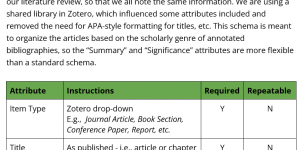The content schema at this Google Doc link was meant as a guideline for the annotated bibliography that would inform the study protocol created with Jiaqi Pei and J.J. Watson-MacKay for LIBR 507 with Dr. Heather O'Brien.
This schema is by no means inventive. The system borrows a lot of the existing content schema created by the Zotero citation management platform, but distills it down to the information that our group had decided we needed in a previous group meeting. The "Summary" attribute is also in part informed by the workshop on annotated bibliographies from the Centre for Writing and Scholarly Communication.
Receiving Feedback
As the actual schema for recording bibliographic information for citations is familiar to most students, most of the feedback I received had more to do with my decisions to make certain attributes required, or on placement hierarchy of the attributes themselves.
However, in my opinion, Publisher location can be made non mandatory, Abstract as mandatory and Tags as mandatory, as they will be useful.
Peer Reviewer #1
I was wondering if the URL should be listed a bit higher, maybe even after the edition attribute?Peer Reviewer #3
Giving Feedback
In giving feedback for this particular assignment, I imagined myself as someone who had been tasked to use this schema for its purpose (e.g., if I were reviewing my own, I would imagine I was inputting information on a journal article). This allowed me to generate questions that related to the clarity of instructions or overall structure:
- What unit of measurement are we using for size: metric or imperial? (to Review Recipient #1)
- Question on the Role attribute: this might be more my unfamiliarity with the game since I haven't played in over a year, but does the game provide you with the DPS/support information, or is this something a cataloger would have to know to fill this attribute out? (to Review Recipient #2)
- The only question I'd have [...] would be for dimensions: Do I measure from the deepest/thickest part, for example if it's a sculpture with an irregular shape? (to Review Recipient #3)
iSchool Graduate Competencies
Below is a self-identified list of competencies that this activity engages as it aligns with the iSchool MLIS Graduate Competencies:
3. Organize and manage information to facilitate access, reflection, and use in a range of contexts
4. Employ information systems and current technologies to address real-world situations, informed by social and cultural perspectives
7. Demonstrate effective collaboration, decision-making and leadership in team settings

While I would not say this assignment took a lot of critical thinking on my part to create compared to giving peer reviews, I found it a good chance for me to reflect on how my extracurricular activities (e.g., attending workshops) and other courses can be brought into the learning in this course.